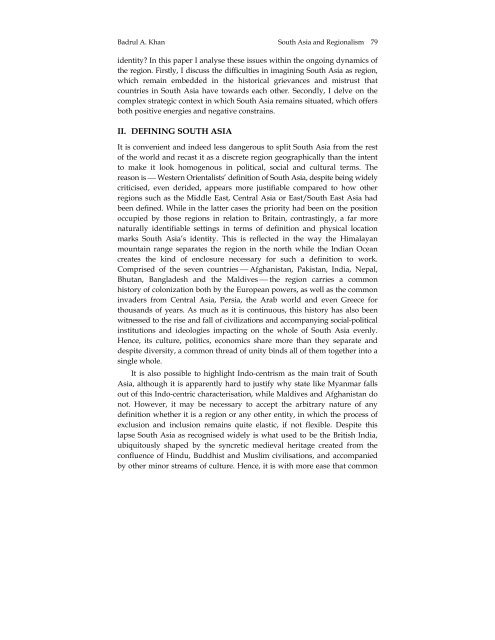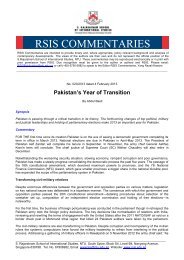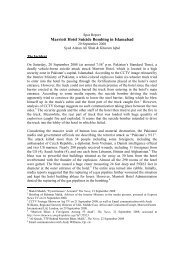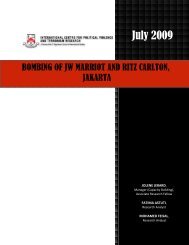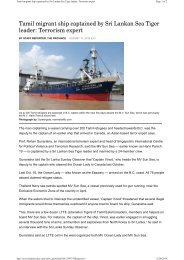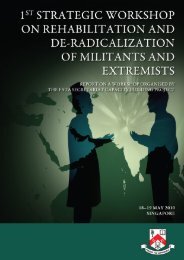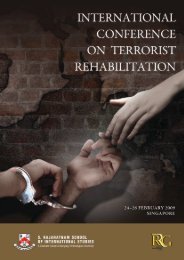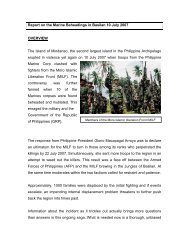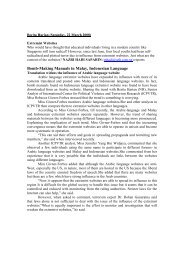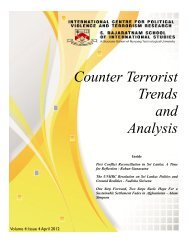Peace and Security Review, Vol.1 No. 2 - International Centre for ...
Peace and Security Review, Vol.1 No. 2 - International Centre for ...
Peace and Security Review, Vol.1 No. 2 - International Centre for ...
You also want an ePaper? Increase the reach of your titles
YUMPU automatically turns print PDFs into web optimized ePapers that Google loves.
Badrul A. Khan South Asia <strong>and</strong> Regionalism 79<br />
identity? In this paper I analyse these issues within the ongoing dynamics of<br />
the region. Firstly, I discuss the difficulties in imagining South Asia as region,<br />
which remain embedded in the historical grievances <strong>and</strong> mistrust that<br />
countries in South Asia have towards each other. Secondly, I delve on the<br />
complex strategic context in which South Asia remains situated, which offers<br />
both positive energies <strong>and</strong> negative constrains.<br />
II. DEFINING SOUTH ASIA<br />
It is convenient <strong>and</strong> indeed less dangerous to split South Asia from the rest<br />
of the world <strong>and</strong> recast it as a discrete region geographically than the intent<br />
to make it look homogenous in political, social <strong>and</strong> cultural terms. The<br />
reason is ⎯ Western Orientalists’ definition of South Asia, despite being widely<br />
criticised, even derided, appears more justifiable compared to how other<br />
regions such as the Middle East, Central Asia or East/South East Asia had<br />
been defined. While in the latter cases the priority had been on the position<br />
occupied by those regions in relation to Britain, contrastingly, a far more<br />
naturally identifiable settings in terms of definition <strong>and</strong> physical location<br />
marks South Asia’s identity. This is reflected in the way the Himalayan<br />
mountain range separates the region in the north while the Indian Ocean<br />
creates the kind of enclosure necessary <strong>for</strong> such a definition to work.<br />
Comprised of the seven countries ⎯ Afghanistan, Pakistan, India, Nepal,<br />
Bhutan, Bangladesh <strong>and</strong> the Maldives ⎯ the region carries a common<br />
history of colonization both by the European powers, as well as the common<br />
invaders from Central Asia, Persia, the Arab world <strong>and</strong> even Greece <strong>for</strong><br />
thous<strong>and</strong>s of years. As much as it is continuous, this history has also been<br />
witnessed to the rise <strong>and</strong> fall of civilizations <strong>and</strong> accompanying social-political<br />
institutions <strong>and</strong> ideologies impacting on the whole of South Asia evenly.<br />
Hence, its culture, politics, economics share more than they separate <strong>and</strong><br />
despite diversity, a common thread of unity binds all of them together into a<br />
single whole.<br />
It is also possible to highlight Indo-centrism as the main trait of South<br />
Asia, although it is apparently hard to justify why state like Myanmar falls<br />
out of this Indo-centric characterisation, while Maldives <strong>and</strong> Afghanistan do<br />
not. However, it may be necessary to accept the arbitrary nature of any<br />
definition whether it is a region or any other entity, in which the process of<br />
exclusion <strong>and</strong> inclusion remains quite elastic, if not flexible. Despite this<br />
lapse South Asia as recognised widely is what used to be the British India,<br />
ubiquitously shaped by the syncretic medieval heritage created from the<br />
confluence of Hindu, Buddhist <strong>and</strong> Muslim civilisations, <strong>and</strong> accompanied<br />
by other minor streams of culture. Hence, it is with more ease that common<br />
<strong>Vol.1</strong>, <strong>No</strong>.2 2008 pp.77-93


